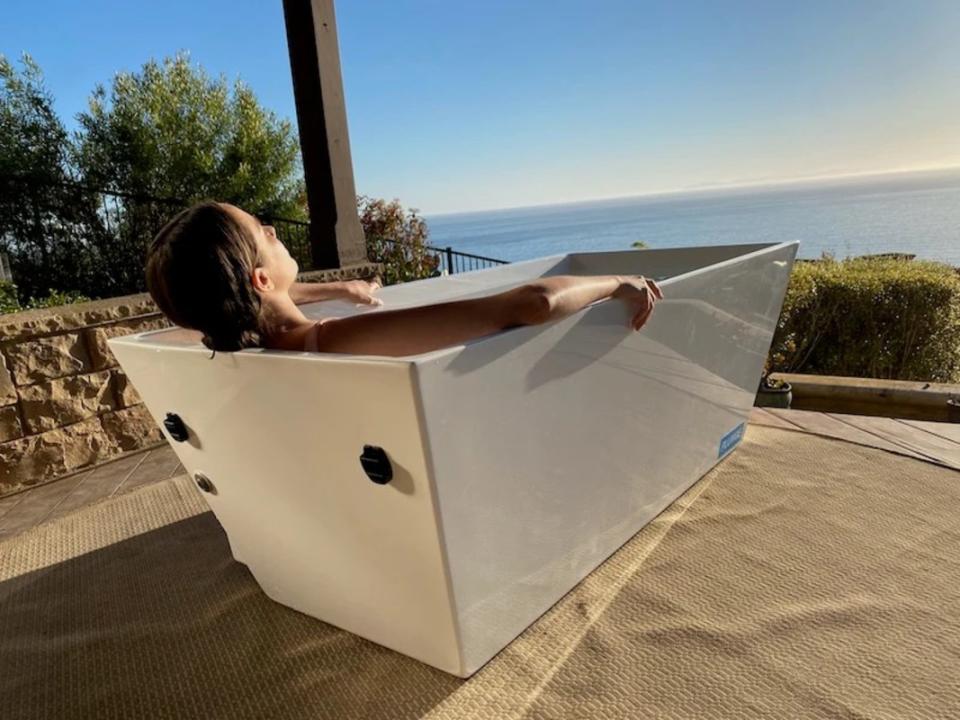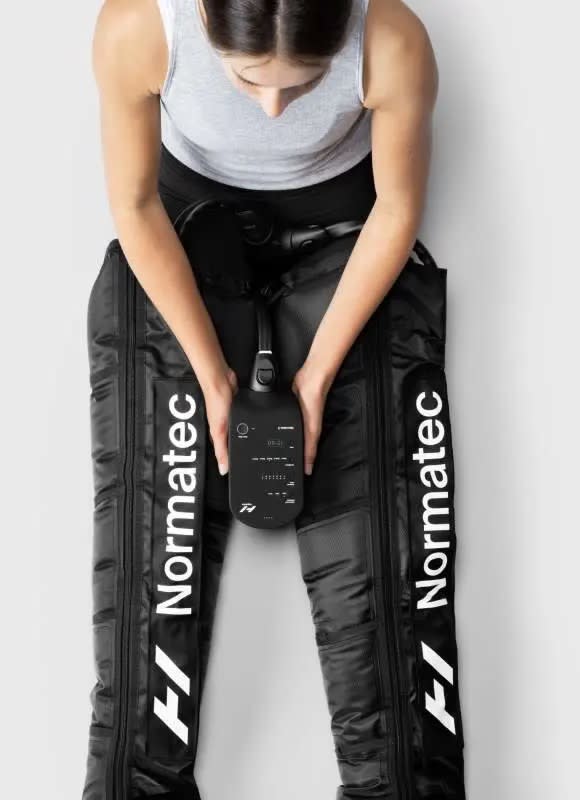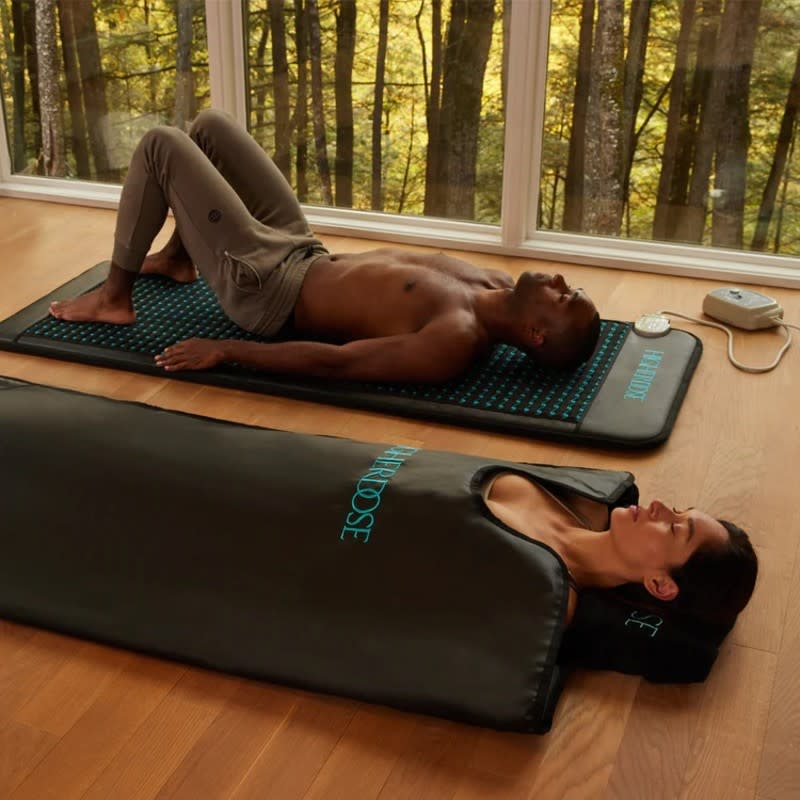The Big Business of At-Home Wellness Technology
In July, TikTok creator Kristen Hollingshaus posted a nine-second clip of herself cozily swaddled in HigherDose's Infrared Sauna Blanket, the siren-red beam of the brand's Red Light Face Mask also flaring from her head.
"When you get a little too into wellness and now this is what your morning routine looks like," the video's text overlay read. Commenters couldn’t get enough.
"I don't know what this is but probably should be doing this," one user, @dietitianwithtwins, wrote.
"Algorithm is TOO REAL IM IN MY SAUNA BLANKET RIGHT NOW SCROLLING," another, @gratitudegirll, said.
"me but i girlbossed too close to the sun and bought a whole sauna," @wondercrochet chimed in.
Today, that video has 6.3 million views, a figure that's roughly equivalent to the population of El Salvador. That's because the $699 electronic sleeping bag isn't the dystopian, Panem-ready gadget it may appear to the untrained eye. HigherDose, with its stable of flashy personal devices is just one member in a growing wave of lifestyle brands making big-ticket, largely inaccessible treatments slightly less inaccessible.
All this begs the question, though: Are people actually buying these pricy tools, once only found in gyms, doctor's offices and spas? The comment section of Hollingshaus's TikTok would suggest they are. But the longer answer is much more interesting. Welcome to the new age of at-home hyper-wellness, with everything from saunas to cold plunges to elaborate massage devices filling the consumer market.
It all goes back, as so many relevant topics do these days, to 2020. We know that COVID-19 entirely changed consumer behavior. But it also changed how those consumers view their bodies, with Americans, in particular, experiencing worsening health since the onset of the pandemic, even unrelated to the actual virus.
In one McKinsey survey, around one in five respondents reported lower physical wellness than before March 2020, while around one in three reported lower emotional wellness. And with the threat of death and disease hanging in the (at times, literal) air, consumers developed a heightened desire to focus on what McKinsey calls "whole-person health," in which one's health and wellness are not limited to physical health, but rather extend toward the wellbeing of, indeed, the whole person.
"Longevity" became a hot new buzzword, with terms like "biological age" and "epigenetic clocks" starting to filter out of white-coated research labs and into more mainstream channels. (To date, the hashtag “#biologicalage" has more than 4 million views on TikTok; a four-part docuseries on the subject — "Live to 100: Secrets of the Blue Zone," taking members around the world to investigate the diet and lifestyles of those living the longest lives — hit Netflix in August 2023.) On the heels of the most severe global health crisis in a century, many began asking: How can we not just have a longer life, but a better one?
"The surge of popularity as it relates to at-home treatments is part of a larger cultural shift as people have started to care more about what is truly important: protecting themselves," says Ryan Duey, co-founder of direct-to-consumer ice-bath brand Plunge. "Investing in high-end, at-home treatments is an investment in yourself. Longevity is the uniting theme of these companies, whether it's a cold plunge, a sauna, a massage gun or gym equipment."

Photo: Courtesy of Plunge
Duey understands the post-COVID whole-person movement because he's a part of it himself. When the world shut down in 2020, Duey's co-founder Michael Garrett was forced to shut down his brick-and-mortar float-spa business and took matters into his own hands: building what the company calls "the world's best cold plunge" in a garage with his dad.
Like the personal infrared sauna blanket, cold-plunge tubs have reached a new level of virality online, with droves of health-conscious patrons submerging themselves in icy water. It's a practice that goes back to, at least, ancient Rome, reportedly helping to decrease inflammation and promote healing by altering blood flow to injured tissues. It also makes for some really great content.
"I think social platforms, especially TikTok, have given all brands, not just high-end wellness-tool brands, a large platform to showcase relatable content in quick, 15-second snippets," says Gina Lucania, vice president of wholesale sales and marketing at Goop, which selse a range of at-home wellness devices. "Creative content creation is key when it comes to getting your brand or product mainstream."
Lucania goes on to explain that, aided in part by social media, brands like Plunge and HigherDose have made higher-end, in-home treatments more accessible. In a world that's returned to normal, busy life, she says, the convenience of stepping into an infrared sauna or hopping into a cold plunge pool at home is worth it for some consumers, regardless of its price tag. After all, how can you put a price on a long, healthy life in mind, body and spirit?
"One positive thing that came out of the pandemic is re-educating ourselves on self-care — DIY manicures, going to YouTube and learning a massage technique, understanding how to use a jade roller on your face," says Lucania. "The consumer still loves convenience, so if you can get into a sauna at home versus driving 30 minutes to your local gym in rush hour traffic? Sign me up."
Jim Huether, CEO of recovery and movement-enhancement technology company Hyperice, also attributes the category's recent momentum to a very contemporary development: more information. Just four years ago, the start of the 2020s ushered in powerful technologies like artificial intelligence, blockchain and the metaverse that have upended traditional systems and for some, even ways of life. The information age and proliferation of online experts are impacting how we consume and react to product. Interested consumers can come across a blog or a podcast on exercise warmup, recovery, nutrition or sleep habits and, within minutes, begin shifting their mindset around health and wellness.
Whereas companies like HigherDose and Plunge address broader wellness concerns, Hyperice skews to a more specific consumer. Its Normatec devices, which range in price from $399 to $1,449, massages tired muscles with targeted air compression, and have grown popular amongst runners and other athletes on TikTok. Which is to say: There's a gadget out there for everyone.

Photo: Courtesy of Hyperice
"At-home wellness is ever-changing and is highly individualized based on one's wellness goals," says Alexandra Zatarian, co-founder and vice president of brand and marketing at "sleep-fitness" brand Eight Sleep. "First, someone might begin exercising, then before they know it, supplements may be a part of their routine. This space has shown to captivate people in a manner that few other industries can."
Like other companies in the space, Eight Sleep took a seemingly mundane element of the everyday human experience — sleep — and wellness-ified it. Didn't this concept already exist with wearables, like an Oura Ring or the humble Apple Watch, you might ask? Not really, no, says Zatarian. Enter: the brand’s $1,895 mattress cover that's stocked with biometric sensors to track sleep, as well as a water cooling grid to help you create an optimal sleeping environment.
"We noticed health-tech wearables were making individuals' exercise and day-to-day behaviors more efficient," she says. "We wondered, why wasn't anyone doing that for sleep? Wellness is loved because it is actionable and measurable; someone will truly feel better by making positive changes in their lives."
HigherDose doesn't explicitly offer sleep-centric products, but in our interview, co-founders Katie Kaps and Lauren Berlingeri point to research that finds that red-light therapy, like the kind the brand offers with its suite of devices, can improve sleep. As it turns out, this is a major motivator for some demographics, more than others, particularly as they age.
"Sleep is reportedly the number-one issue Gen Z is facing, so we anticipate this health goal taking center stage in our overstimulated society," says Berlingeri.

Photo: Courtesy of HigherDose
As we look to the latter half of the 2020s, some experts are forecasting that the wellness-device sector will become even more (actually) accessible — and yes, even more popular. Dr. Jonathan Leary, founder and CEO of fashionable social wellness club Remedy Place, which recently launched its first at-home product (the Remedy Roller, a nearly-$12,000 automated body massager), explains that over time, in-home wellness technology will more seamlessly integrate with other smart home features and offer holistic solutions that consider factors like fitness levels, lifestyle choices and even medical history. Again, it's all about whole-person health.
"The average consumer is becoming more aware of daily stressors, environmental toxins and overall challenges that living in a modern society pose," says Kaps. "We know that being healthy is a lifestyle commitment, so having at-home touchpoints is key to ritualizing your wellness routine."
Please note: Occasionally, we use affiliate links on our site. In no way does this affect our editorial decision-making.
Never miss the latest fashion industry news. Sign up for the Fashionista daily newsletter.

